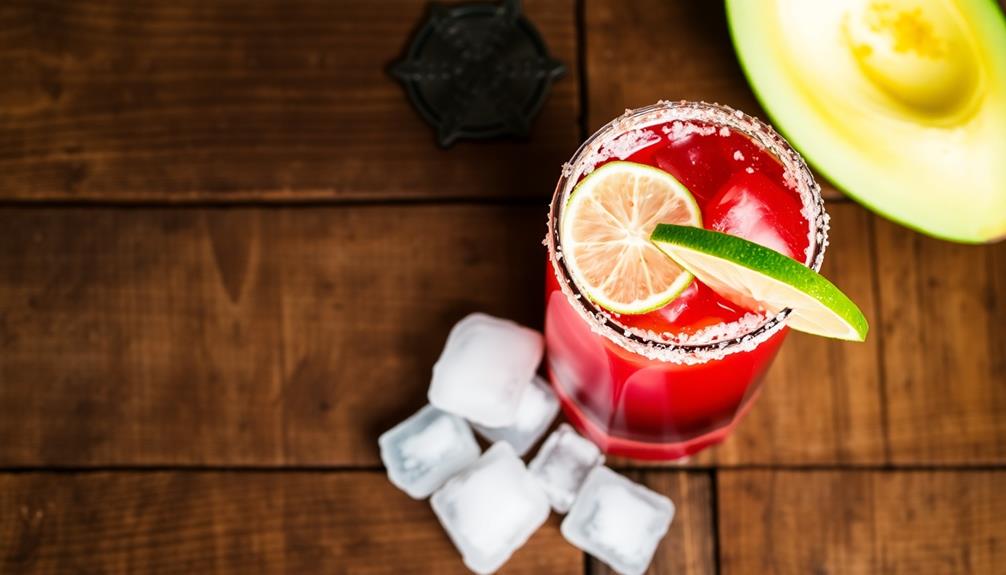Chorizo, the savory Spanish sausage with centuries of culinary tradition, has become a beloved ingredient worldwide, adding bold flavors to a vast array of dishes from tacos to breakfast burritos. You can make your own homemade chorizo by mixing ground pork with paprika, cumin, and garlic powder. Cook it in a skillet until browned and crispy, then fold it into your favorite meals. Chorizo pairs wonderfully with eggs, potatoes, and beans, and you can even enjoy it on its own as a tasty snack. Curious to discover more about this versatile ingredient and how it can elevate your cooking? Let's dive in.
Key Takeaways
- Chorizo is a traditional sausage originating from the Iberian Peninsula with a centuries-old culinary tradition.
- Homemade chorizo requires ground pork, paprika, cumin, and garlic, with a recommended cooking time of 10-15 minutes.
- Chorizo can be used in a variety of dishes, from tacos and empanadas to soups and stews, enhancing the overall flavor profile.
- Chorizo pairs well with ingredients like eggs, potatoes, and crusty bread, and can be enjoyed as a standalone snack or in charcuterie boards.
- While chorizo is flavorful, it can be high in fat and sodium, so moderation is advised, and healthier options are available.
History
Chorizo, a spicy Spanish sausage, has a rich history dating back centuries. The origins of this beloved delicacy can be traced to the Iberian Peninsula, where it has been a staple of the local cuisine for generations. In addition to its use in traditional dishes such as paella and tapas, chorizo is also commonly paired with other Spanish delicacies such as Manchego cheese and Iberico ham. The unique blend of paprika, garlic, and various spices give chorizo its distinctive flavor, which is further enhanced when served alongside the rich, nutty taste of Iberico ham. Whether enjoyed as part of a charcuterie board or incorporated into a mouthwatering stew, chorizo continues to hold a special place in the hearts and palates of food lovers around the world.
The word "chorizo" is derived from the Latin "salsicium," which refers to a type of sausage. Over time, this evolved into the Spanish term we know today. Traditionally, chorizo was made by mixing pork, paprika, garlic, and other spices, then curing the mixture in natural casings.
As Spain's global influence grew, so too did the popularity of chorizo. It became a beloved part of tapas culture, often served alongside other classic Spanish dishes.
Today, chorizo can be found worldwide, with each region putting its own unique spin on the classic recipe. Whether grilled, fried, or incorporated into stews, chorizo remains a beloved and integral part of Spanish culinary heritage.
Recipe
Chorizo is a type of spicy Spanish sausage that adds a bold, smoky flavor to a variety of dishes. Whether you're making a hearty stew, a zesty breakfast hash, or a flavorful pasta sauce, chorizo can be a versatile and delicious addition to your culinary repertoire.
In this recipe, we'll guide you through the process of cooking up a batch of homemade chorizo, perfect for adding to your favorite recipes or enjoying on its own.
Ingredients:
- 2 pounds ground pork
- 2 tablespoons paprika
- 2 teaspoons cumin
- 1 teaspoon garlic powder
- 1 teaspoon onion powder
- 1 teaspoon dried oregano
- 1 teaspoon smoked paprika
- 1 teaspoon salt
- 1/2 teaspoon black pepper
- 1/4 teaspoon cayenne pepper
In a large bowl, combine all the ingredients and mix thoroughly until the spices are evenly distributed. Cover the bowl and refrigerate for at least 30 minutes, or up to 24 hours, to allow the flavors to meld.
When you're ready to cook, heat a large skillet over medium-high heat. Add the chorizo mixture and cook, breaking it up into smaller pieces with a wooden spoon, until it's fully cooked through and browned, about 10-15 minutes. Adjust the heat as necessary to prevent burning.
To ensure your chorizo is cooked to perfection, make sure to use a meat thermometer to check that it reaches an internal temperature of 165°F. This won't only ensure food safety but also result in a juicy, flavorful sausage.
Enjoy your homemade chorizo in your favorite dishes or on its own, with a side of crusty bread or roasted vegetables.
Cooking Steps
Dice the chorizo into small, bite-sized pieces.
Sauté the chorizo in a skillet over medium heat until it's nicely browned and crispy.
Once it's cooked, add any desired seasonings like garlic, onion, or chili powder to give it an extra kick of flavor.
Serve the tasty chorizo warm or at room temperature – it's delicious either way!
Step 1. Dice the Chorizo Into Small Pieces
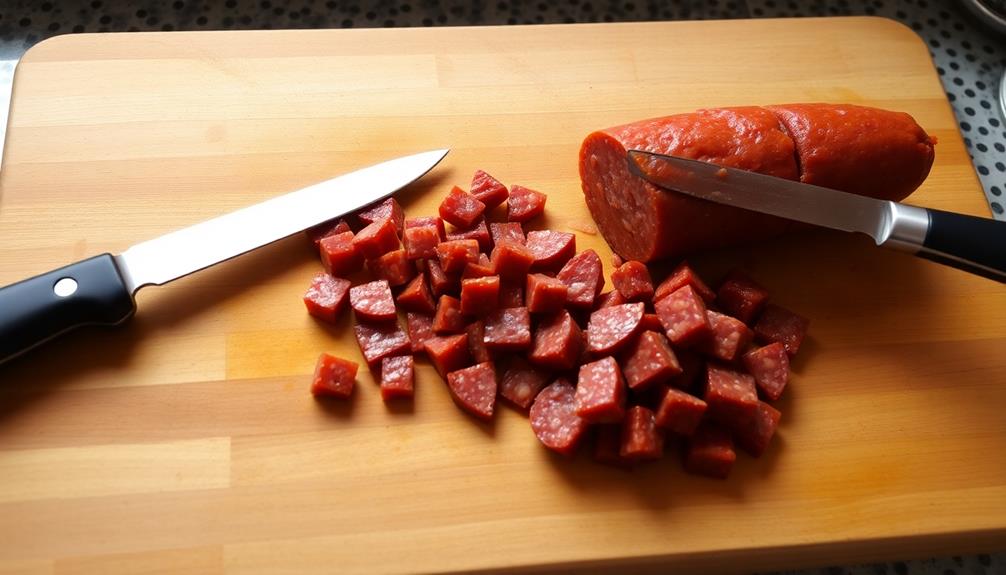
Dicing the chorizo into small pieces is a crucial step in preparing this flavorful sausage for your dish. Using a sharp knife, carefully slice the chorizo into thin rounds.
Then, stack the rounds and cut them into thin strips, creating small cubes or pieces. Aim for pieces around 1/4 inch in size, as this will help the chorizo cook evenly and distribute its bold, spicy flavors throughout your recipe.
Take your time with this step, ensuring each piece is uniform in size. This attention to detail will result in a more cohesive and delicious dish.
Once the chorizo is diced, you're ready to add it to your skillet, stew, or other recipe. The small pieces will sizzle and release their oils, infusing your meal with the signature smoky-spicy taste of chorizo.
With the chorizo diced, you can now move on to the next step in your culinary adventure.
Step 2. Sauté the Chorizo Pieces
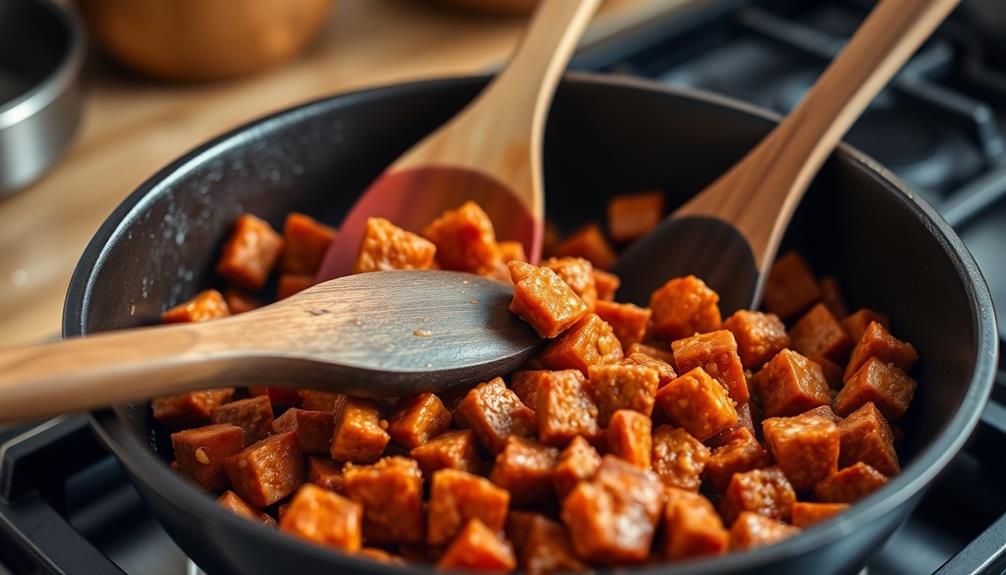
With the chorizo diced into small, uniform pieces, it's time to sauté them to bring out their bold, spicy flavors.
Heat a large skillet over medium-high heat and add a drizzle of oil. Once the oil is shimmering, carefully add the chorizo pieces in a single layer. Sauté for 3-5 minutes, stirring occasionally, until the chorizo is lightly browned and crispy on the edges.
Be careful not to overcrowd the pan, as this can cause the chorizo to steam instead of searing. Work in batches if necessary to maintain the proper heat.
As the chorizo cooks, you'll notice the rich, smoky aroma filling the air. This is the perfect time to adjust the heat if needed to achieve the desired level of browning and crispiness.
Once the chorizo is perfectly sautéed, transfer it to a plate or bowl, ready to be added to your dish. The sizzling, flavorful chorizo pieces are now primed to elevate your culinary creation.
Step 3. Add the Chorizo
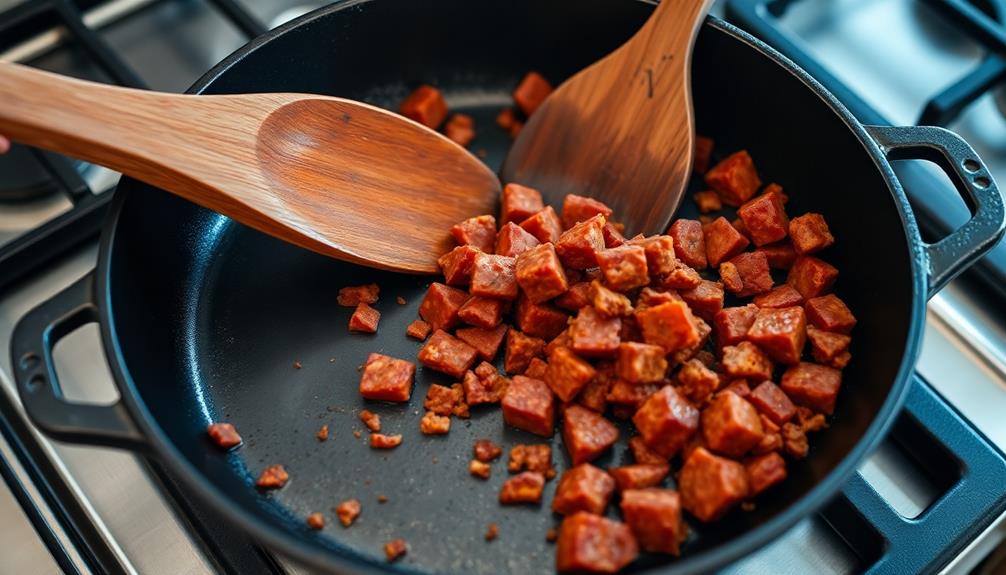
Fold the sautéed chorizo into your dish, allowing its bold, smoky flavors to mingle with the other ingredients. The chorizo's spicy kick and juicy texture will elevate the overall dish, adding depth and complexity. Gently incorporate the chorizo, ensuring it's evenly distributed throughout. This will allow the flavors to meld together, creating a harmonious and satisfying result.
Be mindful not to overcrowd the pan when adding the chorizo. This could cause the meat to steam rather than brown, diminishing its delicious caramelized edges. Work in batches if necessary, allowing each portion to sizzle and develop that irresistible char.
The chorizo's paprika-infused oil will also lend its vibrant color and tantalizing aroma to the entire dish. As the chorizo blends with the other components, take a moment to savor the enticing scent. This will build anticipation for the first tantalizing bite.
With the chorizo now integrated, your dish is well on its way to becoming a flavorful masterpiece.
Step 4. Add Desired Seasonings

Next, add any desired seasonings to enhance the flavors even further. This is your chance to make the chorizo your own!
Consider adding a pinch of smoked paprika to give it a rich, smoky depth. Freshly cracked black pepper can also liven up the mix. For a touch of heat, try stirring in a sprinkle of crushed red pepper flakes. You could even experiment with dried oregano, cumin, or a dash of garlic powder.
Aromatherapy can stimulate the limbic system, which may inspire you to explore unique combinations. The key is to start with small amounts and taste as you go, adjusting the seasonings to suit your personal preferences.
Step 5. Serve Warm or at Room Temperature
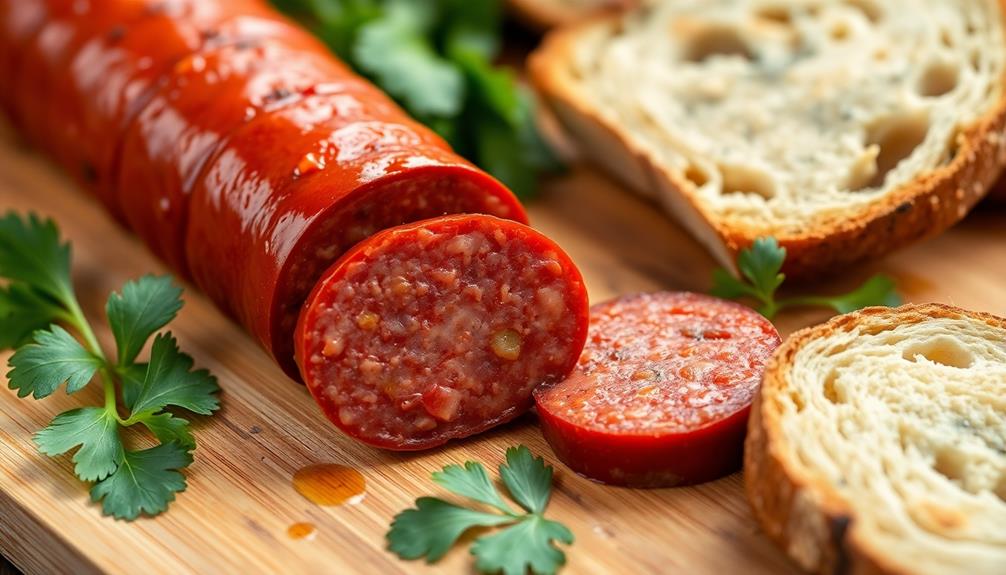
Once your homemade chorizo is fully seasoned, you can either serve it warm or at room temperature, depending on your preferences.
If you choose to serve it warm, simply reheat the chorizo in a skillet or on the grill until it's heated through. This will bring out the bold flavors and create a satisfying texture.
Alternatively, you can serve the chorizo at room temperature, which allows the flavors to meld together and creates a more subtle taste. This option is great for casual gatherings or picnics, as you don't have to worry about keeping the meat hot.
Whichever way you decide to serve it, your guests are sure to enjoy the rich, smoky notes of this delicious sausage.
Pair it with crusty bread, roasted peppers, or your favorite condiments for a truly memorable meal.
Final Thoughts
Ultimately, chorizo's versatility and robust flavor make it a staple ingredient that you can enjoy in a variety of dishes.
Whether you're hosting a lively fiesta or seeking a flavorful addition to your breakfast, this spicy sausage is sure to impress.
Don't be afraid to get creative – chorizo pairs beautifully with eggs, potatoes, rice, and even in soups and stews.
Its bold, smoky notes can elevate any meal, from tacos to empanadas.
And let's not forget the joy of simply snacking on slices of chorizo, perhaps with some crusty bread and a glass of red wine.
Embrace the versatility of this incredible ingredient and let your culinary adventures begin.
Chorizo is a true crowd-pleaser that's sure to become a staple in your kitchen.
Frequently Asked Questions
What Is the Origin of the Name "Chorizo"?
You may be wondering, what's the origin of the name "chorizo"? The word actually comes from the Spanish language, derived from the Latin term "salsicia," meaning sausage. It's a name that's become synonymous with a beloved spicy pork sausage.
How Does the Flavor of Chorizo Differ From Other Sausages?
You might notice that chorizo has a distinct, bold flavor compared to other sausages. Its unique taste comes from the blend of spices, often including smoked paprika, which gives it a smoky, slightly spicy kick.
Can I Substitute Chorizo in Recipes That Call for Other Sausages?
You can substitute chorizo in recipes that call for other sausages, but the flavor will be quite different. Chorizo has a distinct smoked, paprika-forward taste that may overpower the other ingredients in the dish.
How Long Can I Store Unopened Chorizo in the Refrigerator?
Unopened chorizo can generally be stored in the refrigerator for 2-3 weeks. Always check the expiration date and inspect the packaging for any signs of spoilage before consuming. Proper storage will help maintain its flavor and quality.
Is Chorizo a Healthy Addition to My Diet?
Incorporating healthy additions to your diet can provide valuable nutrients, but it's important to consider portion sizes and any potential dietary restrictions. Consulting a healthcare professional can help you determine if a particular food is a suitable fit for your individual needs.

